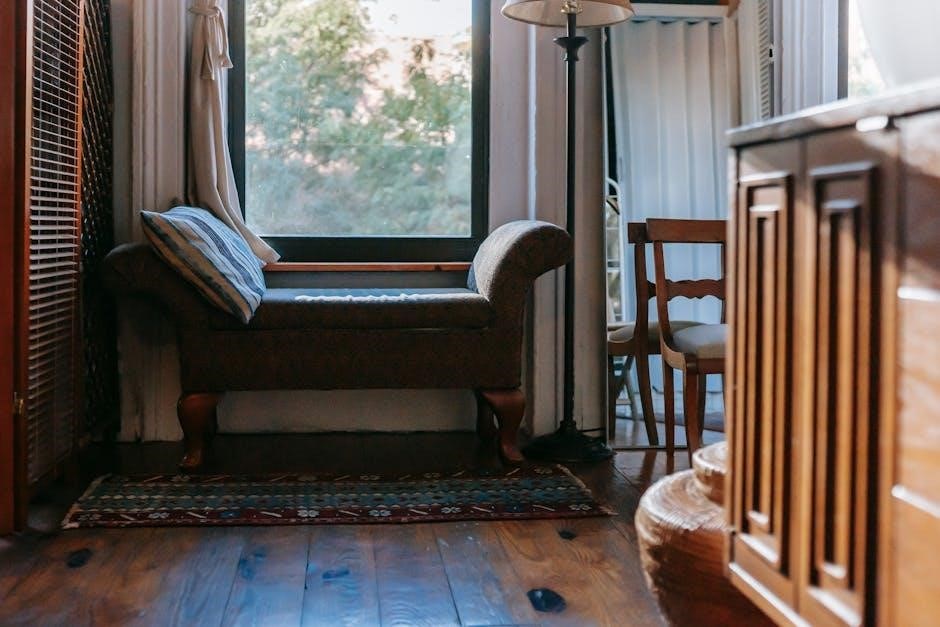Identifying antique rocking chairs requires a keen eye for historical craftsmanship, materials, and design nuances. Understanding the chair’s origins, construction, and unique features helps distinguish genuine antiques from modern reproductions, ensuring accurate valuation and appreciation.

Historical Background of Rocking Chairs
Rocking chairs have a rich history dating back to the early 18th century, evolving through various design periods and influenced by notable craftsmen, reflecting both functionality and artistic expression over time.
The Evolution of Rocking Chairs
The evolution of rocking chairs reflects changing design trends and societal needs over centuries. Originating in the 18th century, early models featured simple, handcrafted designs with straight lines and minimal ornamentation. As craftsmanship advanced, Victorian-era rockers became more ornate, incorporating intricate carvings and upholstered seats. The mid-20th century saw a shift toward modernist designs, emphasizing functionality and minimalist aesthetics. Throughout this journey, rocking chairs transitioned from practical furniture to symbolic pieces of art, influenced by cultural and historical contexts. Understanding this progression aids in identifying authentic antiques, as each era left distinct markers in construction and style.
Key Historical Periods in Rocking Chair Design
Rocking chairs have undergone significant design transformations across key historical periods. The 18th century marked the emergence of early rocking chairs, characterized by simplicity and functionality, often crafted from solid woods like maple and oak. The 19th century saw the rise of Victorian-style rockers, featuring intricate carvings and upholstered seats, reflecting the era’s ornate aesthetic; During this time, the introduction of coil springs and cushioning enhanced comfort. The early 20th century brought the Arts and Crafts movement, emphasizing handcrafted details and natural materials, while the Art Deco period introduced sleek, geometric designs. Mid-century modern designs of the 1950s and 1960s focused on minimalist forms and ergonomic innovation. Each period left a distinct imprint on rocking chair design, making historical context crucial for accurate identification and valuation of antique pieces.
Famous Designers and Their Influence
Famous designers have significantly influenced the evolution of rocking chair design, leaving lasting legacies in craftsmanship and aesthetics. Sam Maloof, known for his mid-century modern designs, revolutionized rocking chairs with his emphasis on organic forms and exceptional woodworking techniques. His pieces are highly sought after by collectors for their seamless blend of functionality and artistry. Michael Thonet, a pioneer of bentwood furniture, introduced innovative manufacturing methods that made rocking chairs more accessible and stylish during the 19th century. His designs, such as the iconic No. 14 chair, incorporated curved lines and ergonomic comfort. John Henry Belter, a prominent figure in Victorian furniture design, created intricately carved rocking chairs that showcased opulent details and refinement. Additionally, the Arts and Crafts movement, influenced by designers like Gustav Stickley, emphasized handcrafted simplicity and natural materials, shaping the aesthetic of early 20th-century rocking chairs. These designers’ contributions continue to inspire contemporary furniture makers and influence the valuation of antique rocking chairs.
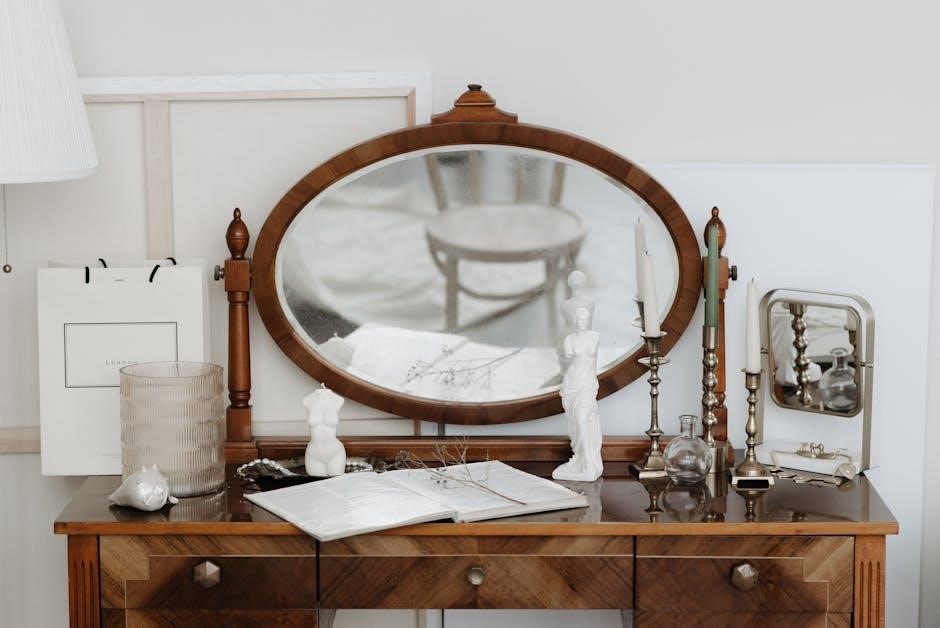
Materials and Construction
Antique rocking chairs were often crafted from solid hardwoods like oak, maple, and mahogany, ensuring durability. Traditional construction methods included mortise and tenon joints, dovetailing, and hand-carved details, reflecting exceptional craftsmanship and attention to detail.
Common Woods Used in Antique Rocking Chairs
Antique rocking chairs were typically constructed from high-quality, durable hardwoods that offered both strength and aesthetic appeal. Oak, maple, cherry, and mahogany were among the most common woods used. Oak was prized for its robustness and longevity, often resulting in pieces that withstood decades of use. Maple, known for its light color and fine grain, was frequently used for its versatility and resistance to wear. Cherry and walnut were favored for their rich, dark hues and fine grain patterns, adding a touch of elegance to the chairs. These woods were often sourced from local regions, with American manufacturers relying on domestic hardwoods. The choice of wood significantly influenced the chair’s durability, comfort, and overall value. Identifying the type of wood is a crucial step in determining the chair’s age, origin, and authenticity, making it essential for collectors and enthusiasts to recognize these classic materials.
Hardware and Joinery Techniques
Antique rocking chairs often showcase traditional hardware and joinery methods that reflect the craftsmanship of their time. Mortise and tenon joints, dovetail connections, and hand-forged nails were commonly used, ensuring durability and stability. The presence of flat head screws, rather than modern Phillips heads, can indicate an older piece. Hardware such as hinges, brackets, and runners was often made of iron or brass, with visible handtooling that adds to the chair’s authenticity. Hand-carved components, like intricate joints or carved runners, suggest a piece crafted by skilled artisans. These techniques not only contribute to the chair’s structural integrity but also reveal its historical context and value. Examining the hardware and joinery can help distinguish genuine antiques from later reproductions, making these elements critical in the identification process.
Surface Finishes and Paint Techniques
Surface finishes and paint techniques on antique rocking chairs provide valuable clues about their age, craftsmanship, and historical context. Many chairs feature hand-applied finishes, such as shellac, varnish, or oil-based paints, which may exhibit subtle cracking or patina over time. Early pieces often showcase natural wood tones, while later designs might include decorative paints or stenciling. Wear patterns, such as armrests worn smooth or paint loss on high-contact areas, indicate years of use. Hand-painted designs, like floral motifs or geometric patterns, were popular in certain periods and can help date the chair. Distressing techniques, such as intentional wear or faux aging, were sometimes applied to mimic the appearance of older pieces. Analyzing the finish and paint can reveal restoration efforts or original detailing, both of which impact the chair’s authenticity and value. These visual cues are essential for identifying and appraising antique rocking chairs accurately.
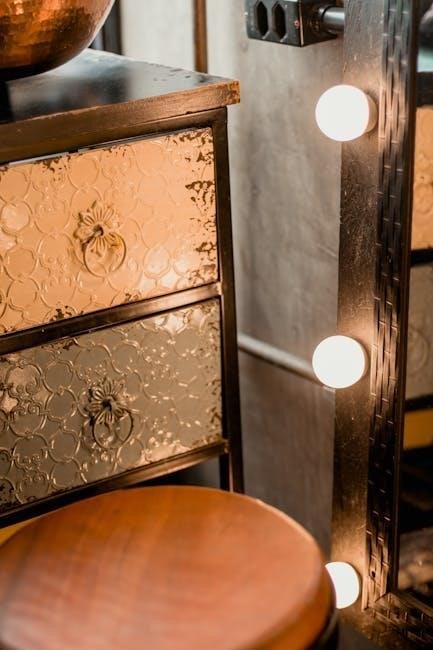
Design Elements
Antique rocking chairs showcase a variety of design elements, reflecting their historical context and craftsmanship. From ornate carvings to minimalist lines, these chairs often feature unique details that highlight their era and artistic influence. Ergonomic designs, such as curved runners and contoured seats, emphasize comfort and functionality, while decorative elements like intricate upholstery or hand-painted motifs add aesthetic appeal. Understanding these design nuances helps enthusiasts appreciate the chair’s craftsmanship and historical significance, making them treasured collectibles.
Types of Rocking Chair Styles
Antique rocking chairs come in a variety of styles, each reflecting distinct historical periods and design influences. The Boston Rocker, characterized by its curved runners and upholstered seat, is one of the most iconic styles. Windsor Rockers, known for their slender spindles and open back design, offer a more minimalist aesthetic. Platform Rockers, with their flat, rocker-less bases, provide a unique take on traditional designs. Other styles include the fan-back rocker, featuring a curved back with horizontal slats, and the ladder-back rocker, with vertical slats and a simpler frame. Each style often incorporates specific woods, such as maple or oak, and may feature intricate carvings or hand-painted motifs. Understanding these styles helps enthusiasts identify and appreciate the craftsmanship of antique rocking chairs, making them valuable additions to any collection.
Ornamentation and Carvings
Ornamentation and carvings on antique rocking chairs are key elements that reveal craftsmanship and historical influence. Intricate carvings, such as floral motifs, scrollwork, or geometric patterns, were often hand-carved by skilled artisans. During the Victorian era, chairs frequently featured elaborate designs, while earlier periods like the Federal or Georgian styles favored more restrained ornamentation. Carvings might also reflect regional influences, with Southern or Shaker styles showcasing unique motifs. Inlays, such as contrasting wood veneers, added visual interest. Some chairs bore patriotic or symbolic carvings, indicating cultural or personal significance. The level of detail and quality of execution can help determine the chair’s age and value. Less elaborate carvings might still demonstrate exceptional craftsmanship, especially in simpler designs. These decorative elements not only enhance the chair’s aesthetic appeal but also provide clues about its origins and historical context, making them essential for identification and appreciation.
Ergonomic Features and Comfort
Antique rocking chairs were designed with both functionality and comfort in mind, reflecting the ergonomic principles of their time. The curved backrests and angled seats were crafted to provide natural spinal support, while the armrests offered additional comfort and ease of use. The rocker’s motion was carefully balanced to create a soothing, gentle sway, enhancing relaxation. Many chairs featured wide seats and generous proportions to accommodate various users comfortably. The placement of the runners (the curved supports beneath the chair) was critical to ensure smooth, even movement. While modern ergonomics may differ, these chairs were often tailored to the needs of their era, with designs that prioritized long-term comfort for everyday use. The combination of thoughtful design and craftsmanship made antique rocking chairs both functional and enduringly comfortable, contributing to their lasting appeal. These features remain important considerations for identifying and valuing antique rocking chairs today.
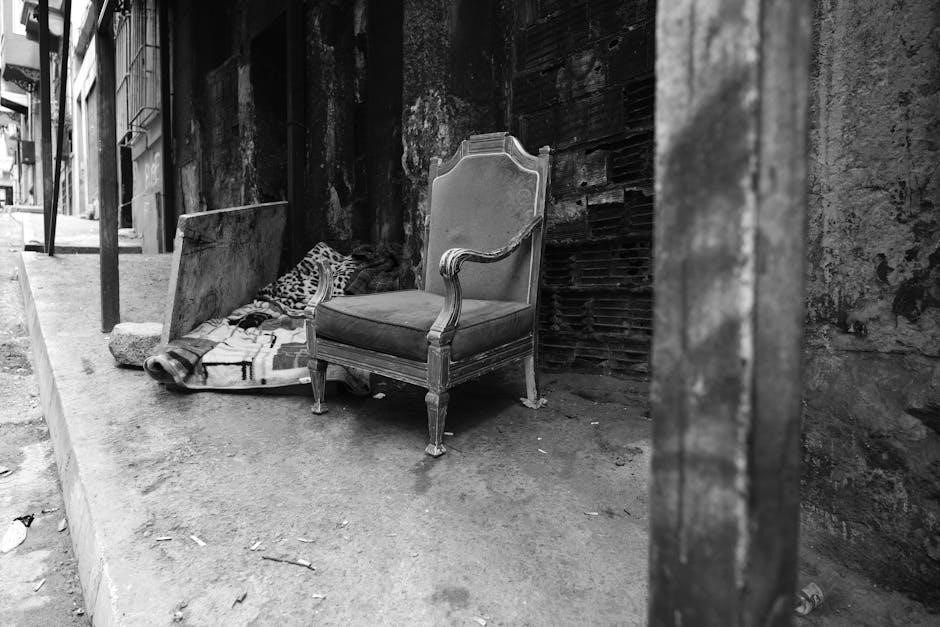
Manufacturer Marks and Signatures
Manufacturer marks and signatures are crucial for identifying the maker and authenticity of an antique rocking chair. These marks, often found on the underside or backrest, can help verify the chair’s origins and date, ensuring its legitimacy and historical value.
How to Identify Maker’s Marks
Identifying maker’s marks on antique rocking chairs involves a meticulous examination of the chair’s construction. These marks, often stamps, signatures, or labels, are typically found on the underside, backrest, or frame. They may include the manufacturer’s name, initials, or symbols, which can provide valuable clues about the chair’s origins and date. When inspecting, look for consistency in the mark’s style and placement, as genuine marks are usually discreet and professionally applied. Comparing the mark to known examples in reference materials or databases can help verify its authenticity. Additionally, the presence of serial numbers or patent dates can further aid in pinpointing the chair’s era and maker. Keep in mind that some marks may have faded or worn over time, so using magnification tools can be beneficial. Always document your findings to cross-reference with historical records or consult with experts for confirmation.
Deciphering Serial Numbers and Signatures
Deciphering serial numbers and signatures on antique rocking chairs is a critical step in identifying their origin and value. Serial numbers, often found on the chair’s frame or underside, can reveal the manufacturer and production date. Signatures, which may be stamped, engraved, or handwritten, provide direct attribution to the craftsman or company. To decode these marks, researchers use reference guides, manufacturer databases, and historical records. Look for consistency in the numbering or signing style, as genuine marks are typically precise and professionally executed. Some signatures may include symbols or codes that require specialized knowledge to interpret. If the mark is faint or worn, use magnification tools to enhance visibility. Documenting the mark and comparing it to known examples can help verify authenticity. Remember, not all antique chairs bear visible marks, as some craftsmen did not sign their work. In such cases, focus on other identifying features like construction techniques and materials to piece together the chair’s history.
The Importance of Provenance
Provenance, the documented history of an antique rocking chair’s ownership and origins, is vital for establishing authenticity, value, and cultural significance. A well-documented provenance can trace the chair’s journey through generations, connecting it to historical events, prominent families, or esteemed craftsmen. This historical context not only enhances the chair’s appeal but also verifies its legitimacy in the market. Provenance is typically supported by invoices, receipts, letters, or expert appraisals, which serve as evidence of the chair’s lineage. Understanding the chair’s past helps collectors and appraisers assess its rarity and condition, factors that significantly influence its value. Additionally, provenance can reveal restoration efforts or notable exhibitions, further enriching the chair’s story. For enthusiasts, uncovering a chair’s provenance is akin to uncovering a piece of history, making it an essential part of the identification process. Always research and verify provenance through reputable sources to ensure accuracy and trustworthiness.

Condition and Patina

Condition and patina are crucial in evaluating antique rocking chairs. Wear patterns reveal authenticity, while patina, the chair’s natural aging process, enhances its historical charm. Both factors significantly influence its value and desirability.
Understanding Wear and Tear Patterns
Wear and tear patterns on antique rocking chairs provide vital clues about their history and authenticity. Areas like the seat, armrests, and rockers often show signs of frequent use, such as indentations or smoothness from prolonged contact. The type of wear can indicate how the chair was used, with uneven rocker wear suggesting heavy use. Hardwood chairs, like those made from oak or maple, may exhibit different wear compared to softer woods. Metal components can corrode, and finishes may fade in high-use areas, offering insights into the chair’s age. Genuine wear adds character and can be distinguished from artificial distressing. Consistent wear patterns aligning with the chair’s age enhance its value, while inconsistencies may indicate reproduction or restoration. The absence of significant wear might suggest a newer piece, whereas excessive wear could affect structural integrity and value. Understanding these patterns is crucial for accurate identification and valuation of antique rocking chairs.
The Impact of Patina on Value
Patina, the natural aging process on antique rocking chairs, significantly influences their value. A well-developed patina often enhances authenticity and aesthetic appeal, as it reflects the chair’s history and age. Collectors and appraisers view patina as a testament to the chair’s genuine antiquity, which can escalate its market value. However, excessive wear or uneven patina may signal overuse or poor condition, potentially diminishing worth. The patina’s consistency across the chair is crucial; inconsistencies might suggest repairs or alterations, affecting value. Additionally, patina can obscure minor flaws, preserving the chair’s original character. The interplay of patina with the chair’s materials, such as wood type, further impacts its valuation. While patina generally boosts value by highlighting the chair’s heritage, its condition and uniformity are key factors in determining market desirability and price. Thus, patina is a critical element in assessing the value of antique rocking chairs.

How to Assess the Chair’s Condition
Evaluating the condition of an antique rocking chair involves a thorough inspection of its structural integrity, surface quality, and overall preservation. Begin by examining the chair for signs of wear, such as cracks, dents, or loose joints, which may indicate age-related stress or improper handling. Check the stability of the rockers and the sturdiness of the legs, ensuring they are firmly attached and functional. Inspect the seat, backrest, and armrests for warping, splintering, or excessive scratches. The finish, whether painted or stained, should be assessed for flaking, fading, or restoration work. Look for any maker’s marks or signatures, which can provide clues about the chair’s origin and authenticity. Use a magnifying glass to examine intricate carvings or details for signs of handcraftsmanship. Finally, test the chair’s comfort and functionality by gently rocking it to ensure smooth movement. A well-maintained chair with minimal damage and original components will typically hold higher value. Always compare your findings with historical examples to validate your assessment;

Valuation and Appraisal
Valuation and appraisal of antique rocking chairs involve assessing factors like rarity, craftsmanship, and provenance to determine their market value. Consulting experts ensures accurate appraisals and helps sellers and collectors understand their chair’s worth.
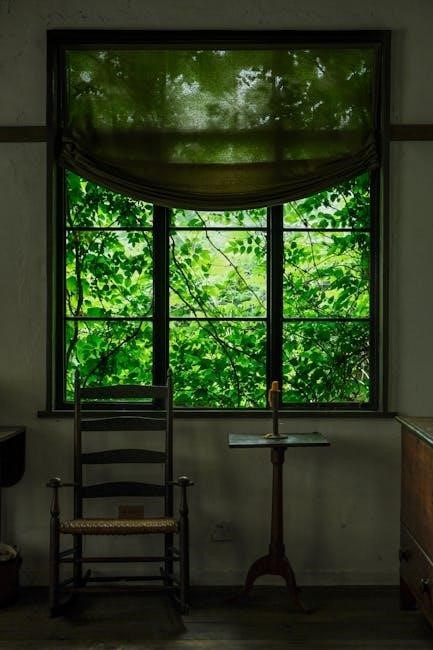
Factors Affecting the Value of Antique Rocking Chairs
The value of antique rocking chairs is influenced by several key factors, including rarity, historical significance, and condition. Chairs crafted from premium materials like mahogany or walnut typically command higher prices due to their durability and aesthetic appeal. The presence of intricate carvings, hand-painted designs, or unique ergonomic features can also elevate value. Provenance, such as a chair’s connection to a notable designer or historical figure, significantly impacts its worth. Additionally, market demand plays a role, with certain styles like Boston rockers or Victorian-era designs often being more sought after. The chair’s condition is crucial; well-preserved pieces with minimal wear and tear fetch higher prices than those requiring restoration. Finally, the expertise of appraisers and the reputation of the seller or auction house can influence the final valuation, making professional assessment essential for accurate pricing.
How to Get a Professional Appraisal
Obtaining a professional appraisal for an antique rocking chair involves several steps to ensure accuracy and reliability. First, research and identify reputable appraisers specializing in antique furniture, ideally those certified by recognized organizations. Next, gather detailed information about the chair, including its history, materials, and any maker’s marks or signatures. Photographs from multiple angles, along with close-ups of intricate details, should be prepared for the appraiser’s review. When scheduling the appraisal, inquire about the process, costs, and the appraiser’s experience with similar pieces. During the appraisal, the expert will examine the chair’s construction, condition, and provenance to determine its value. A written report detailing the findings and estimated value will typically be provided. Additionally, considering second opinions or consulting multiple experts can provide a broader perspective. It’s important to choose an appraiser who is impartial and has no vested interest in the sale of the piece, ensuring an unbiased assessment.
Current Market Trends
Current market trends in antique rocking chairs reflect a growing interest in vintage and sustainable home decor. Collectors and enthusiasts are increasingly seeking pieces that combine historical significance with functional design. Mid-century modern and Victorian-style rocking chairs are particularly in demand, driven by their timeless aesthetics and craftsmanship. Additionally, there is a rise in appreciation for chairs made from rare or figured woods, such as mahogany and walnut, which are prized for their beauty and durability.
The demand for antique rocking chairs is also influenced by regional preferences, with American and European styles garnering significant attention. Online marketplaces and auctions have made it easier for buyers to discover and purchase these pieces, contributing to their popularity. Furthermore, the trend toward eco-conscious living has boosted the appeal of antique furniture, as it offers a sustainable alternative to modern mass-produced items. Overall, the market for antique rocking chairs remains robust, with prices fluctuating based on rarity, condition, and provenance.
